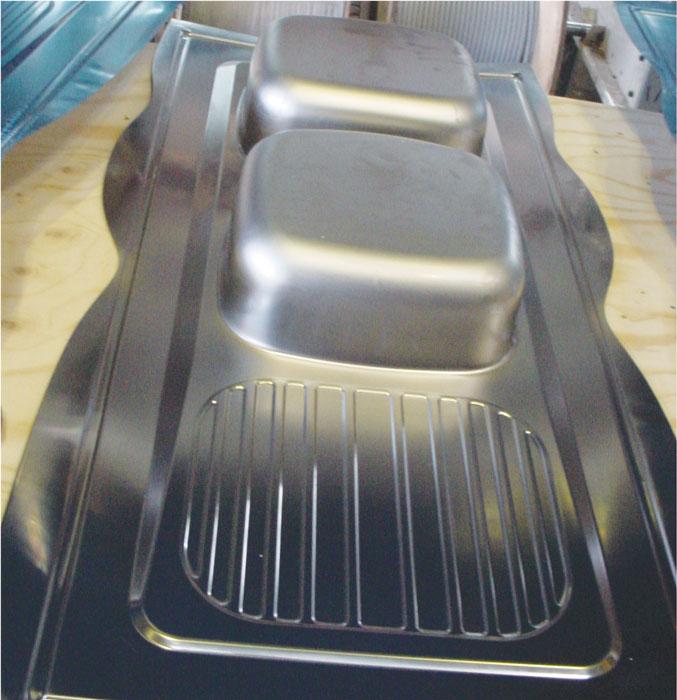Contributing Writer
- FMA
- The Fabricator
- FABTECH
- Canadian Metalworking
Categories
- Additive Manufacturing
- Aluminum Welding
- Arc Welding
- Assembly and Joining
- Automation and Robotics
- Bending and Forming
- Consumables
- Cutting and Weld Prep
- Electric Vehicles
- En Español
- Finishing
- Hydroforming
- Laser Cutting
- Laser Welding
- Machining
- Manufacturing Software
- Materials Handling
- Metals/Materials
- Oxyfuel Cutting
- Plasma Cutting
- Power Tools
- Punching and Other Holemaking
- Roll Forming
- Safety
- Sawing
- Shearing
- Shop Management
- Testing and Measuring
- Tube and Pipe Fabrication
- Tube and Pipe Production
- Waterjet Cutting
Industry Directory
Webcasts
Podcasts
FAB 40
Advertise
Subscribe
Account Login
Search
Die Science: Stainless steel stamping
Part 1: Know your material
- By Art Hedrick
- Updated January 19, 2023
- July 27, 2017
- Article
- Bending and Forming

To stamp stainless steel, you have to understand the mechanical ability of the material being stamped and design the process around the material’s behavior.
For instance, designing a die to cut and form stainless steel requires a good understanding of its unique behavior. Many stampers have tried unsuccessfully to form and cut stainless steel in dies that were engineered for plain carbon steel. To stamp stainless steel, you have to understand the mechanical ability of the material being stamped and design the process around the material’s behavior.
What is Stainless Steel?
Stainless steel is the name given to special corrosion-resistant, high temperature steel. Their good resistance to corrosion is due to a chromium-rich oxide film that forms on the surface.
When ordinary carbon steel is exposed to moisture, it corrodes, forming a brown iron oxide layer, or rust. But when enough chromium (more than about 10 percent) is added to ordinary plain carbon steel, the oxide on the surface is transformed into a nearly invisible and protective layer that can be used in many corrosive media.
Hundreds of speciality stainless steels are available. Some are used for extreme corrosion resistance, and others are used of their ability to withstand high heat. Others have good resistance to both. Alloys such as nickel often are added to stainless steel to give it certain desired properties.
What is Stainless Steel Used For?
Stainless steel has thousands of applications, for everything from kitchen sinks to pocket knife blondes to screw used in the marine industry. One of the more familiar items made of stainless stele is flatware (see Figure 1 ), sometimes called “good”, “better”, or “best” in retail stores. What separates these grades is the amount of nickel added to the stainless to give it luster and brilliance. For example, the “good” stainless is usually 18-0 stainless steel. This means that the steel has 18 percent chrome and no nickel. In comparison, the “best” grade is 18-10, which means it has 18 percent and 10 percent nickel.
Stainless steel that is used for items such as pocket knives and surgical tool s has much more carbon in it. Carbon allows the steel to be hardened using a heat-treating process. Other types of stainless steel, such as the type used for forming a kitchen sink, have low carbon content, resulting in a softer, more stretchable material.
Stainless steel also is used commonly in the automotive industry. The exhaust of an automobile is mostly made up of a high-temperature grade of stainless steel.
Three Basic Types of Steel
Three basic types of steel are used in the stamping industry: austenitic, ferritic, and martensitic.
Austenitic . The austenitic grade usually is chosen for deep drawing. Austenitic grades typically contain lower carbon, which makes them highly suitable for making items such as kitchen sinks, deep fat fryers, and other deep formed parts (see Figure 2 ).
Austenitic grades cannot be hardened with her treating, but instead by cold working the metal. They contain chromium and nickel, as well as other small amounts of alloys. Austenitic stainless steel has the greatest formability of any of the grades.
Two very common types of austenitic stainless steel are 304 and 304L (usually very low carbon content) and 316 and 316L (marine grades). This type of stainless is it annealed state.
Ferritic . The ferric grade is popular in the automotive industry, which requires resistance to both corrosion and heat. Depending on the amount of carbon and other alloys in the steel, ferritic grades also can have decent formability.
Unlike austenitic grades, ferritic grades do not contain nickel, and they are magnetic. They also are suitable for drawing. Typical applications include automobile exhaust systems, dishwashers, and dryers (see Figure 3 ).
Three typical types of ferritic stainless steel are 409, 439, and 430.
Martensitic . Martensitic stainless steel is very similar to ferritic stainless steel, but with one main difference: Martensitic stainless steel has a greater amount of carbon. This allows the steel to be heat-treated. Heat treating the stainless increases its hardness, resulting in steel that is ideal for making cutting tools, knives, and surgical tools (see Figure 4 ).
Unlike ferritic and austenitic grades, martensitic stainless steel is not suitable of drawing and stretching. It is strong and hard but brittle and difficult to form and weld. Typical applications include razor blades, pocket knives, tweezers, ball bearings, and plastic injection methods.
The most common type of this magnetic material is 420.
Three Tempers for Stamping Stainless Steel
Each grade of stainless steel can be either cold-worked or heat-treated to give it a specific strength. Most stainless steel provides designate the stainless steel’s hardness in one of five ways:
- Dead soft —Fully annealed condition, as soft as possible
- Quarter hard —Partially cold worked or heat-treated, with a slight increase in toughness and strength
- Half hard —Greater hardness achieved by further cold working or heat treating, and great toughness and strength
- Three-quarter had —Almost fully hardened, but with some minor malleability left, and very tough
- Full hard —Fully hardened, borderline brittle, with poor formability
The key to forming and cutting stainless steel is first to have a good understating of its type, hardness, and formability. Knowing you materials will affect the design of your process.
Until next time… Best of luck!
About the Author

Art Hedrick
10855 Simpson Drive West Private
Greenville, MI 48838
616-894-6855
Related Companies
subscribe now

The Fabricator is North America's leading magazine for the metal forming and fabricating industry. The magazine delivers the news, technical articles, and case histories that enable fabricators to do their jobs more efficiently. The Fabricator has served the industry since 1970.
start your free subscription- Stay connected from anywhere

Easily access valuable industry resources now with full access to the digital edition of The Fabricator.

Easily access valuable industry resources now with full access to the digital edition of The Welder.

Easily access valuable industry resources now with full access to the digital edition of The Tube and Pipe Journal.
- Podcasting
- Podcast:
- The Fabricator Podcast
- Published:
- 04/16/2024
- Running Time:
- 63:29
In this episode of The Fabricator Podcast, Caleb Chamberlain, co-founder and CEO of OSH Cut, discusses his company’s...
- Industry Events
16th Annual Safety Conference
- April 30 - May 1, 2024
- Elgin,
Pipe and Tube Conference
- May 21 - 22, 2024
- Omaha, NE
World-Class Roll Forming Workshop
- June 5 - 6, 2024
- Louisville, KY
Advanced Laser Application Workshop
- June 25 - 27, 2024
- Novi, MI

































